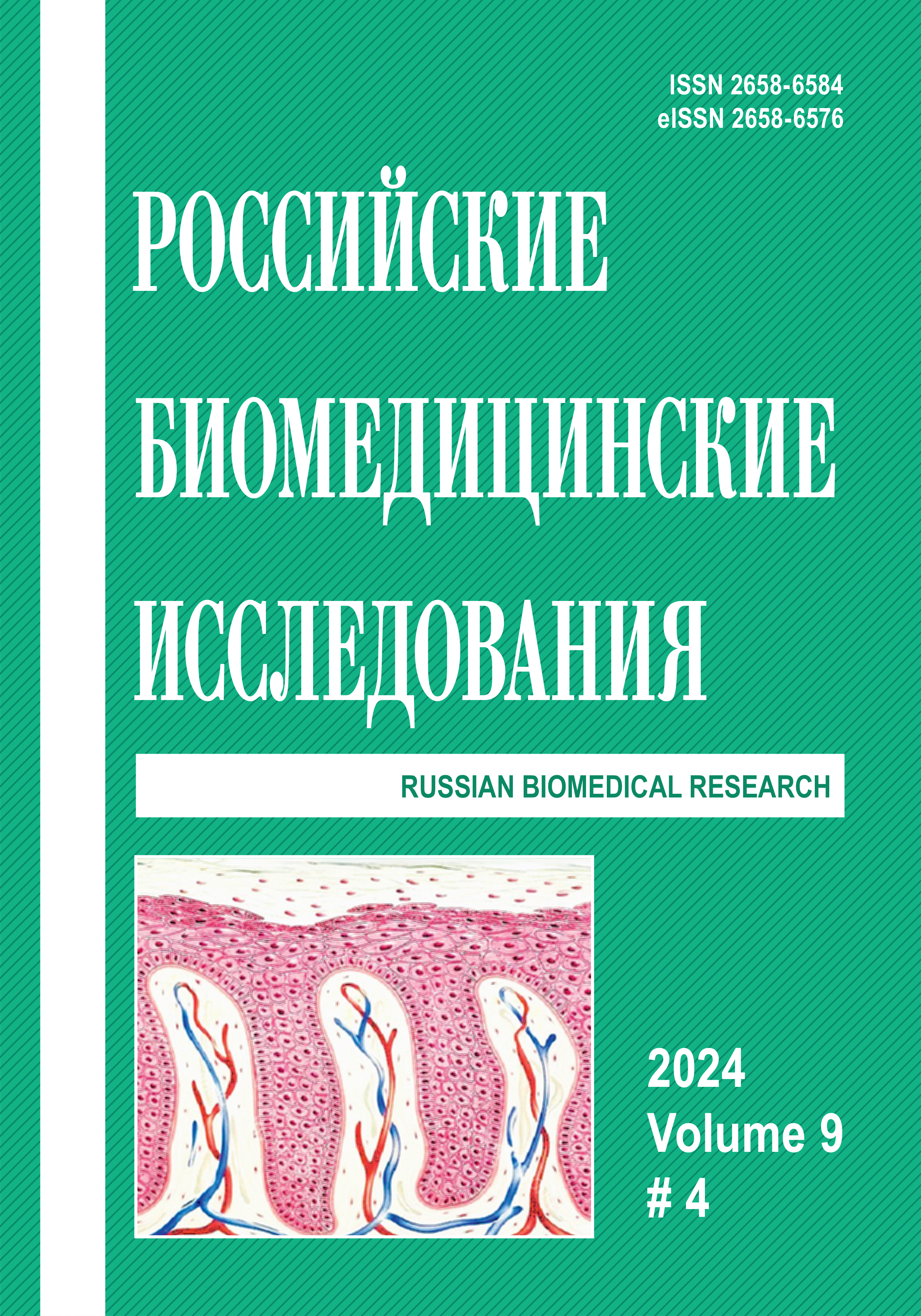ON THE TREMATODE FAUNA OF FISH OF THE FAMILY PERCIDAE IN THE LAKE VEROYARVI OF LENINGRAD REGION
Abstract
Introduction. The lakes of the Vsevolozhsky District of the Leningrad Region are considered to be popular places of tourist importance, where intensive amateur fishing is conducted. Data on the parasite fauna of the fish species most commonly found in the biocenoses are important in ichthyopathology and medicine. The aim of the study was to determine the systematic affiliation of trematode larvae in fish of the family Percidae from Lake Veroyarvi in the Vsevolozhsky District of the Leningrad Region and to assess the safety of objects of fishing by the presence of trematode larvae pathogenic to humans. Materials and methods. The material was collected in the summer and autumn of 2022–2023. 15 individuals of perch (Perca fluviatilis) were studied by the method of complete parasitological autopsy. Fixation and staining of the detected trematode metacercariae were performed using carmine acetic acid. The fixed samples were studied using an XSP-128-201 binocular microscope. Results. Metacercariae of the family Diplostomidae were found in the eyes of 14 out of 15 individuals of the perch. Numerous metacercariae of the Strigeidae family have been identified in the connective tissue membrane of the swim bladder, the parenchyma of the ovary, and mesentery of fish. Based on the analysis of the literature data, the life cycles, vertebrate and invertebrate hosts of the identified trematodes are considered. The first intermediate hosts are gastropods; fish of the Percidae family are the second intermediate hosts. Vertebrates, mainly birds, act as the final hosts. Conclusion. Larvae of trematodes of the families Diplostomidae and Strigeidae, which do not pose a danger to humans, have been identified in the organisms of fish of the Percidae family in Lake Veroyarvi, Leningrad Region.
References
Абдукаева Н.С., Косенкова Н.С., Васильева Н.В., Федюк К.А., Обелевич Е.В. Медицинская паразитология. Часть 1. Протозоология и гельминтология. СПб.: Изд-во СПбГПМУ; 2024.
Абдукаева Н.С., Косенкова Н.С., Грачева Т.И., Васильева Н.В. Speсial questions of parasitology. СПб.: Изд-во СПбГПМУ; 2018.
Быховская-Павловская И.Е. Паразиты рыб. Руководство по изучению. Л.: Наука; 1985.
Гинецинская Т.А., Добровольский А.А. Частная паразитология. Т. 1. Под ред. Ю.И. Полянского. М.: Высшая школа; 1978.
Грязев В.С., Ибрагимов Ш.М. Паразитофауна щуки обыкновенной (Esox lucius) из Ладожского озера. Материалы конференции «Студенческая наука 2022». 2022: 399–400.
Козлов С.С., Ермакова Л.А., Турицин В.С., Зотова М.А. Случай тонзиллита, вызванного паразитированием Clinostomum complanatum. Эпидемиология и инфекционные болезни. 2023;28(6):401–406. DOI: 10.17816/EID608179.
Кудрявцева Т.М. Распространение метацеркарий сем. Opisthorchiidae в рыбах водоемов Северо-Запада России (эпизоотология, диагностика). Дисс. ... канд. ветеринар. наук СПб.: 2020.
Лебедева Д.И. Трематоды рыб Ладожского озера. Биогеография Карелии. Труды Карельского научного центра РАН. 2005; 7:174–180.
Определитель паразитов пресноводных рыб фауны СССР. В 3 т. под ред. О.Н. Бауера. Л.: Наука. Ленингр. отд-ние; 1984.
Орлова Д.А. Оценка доброкачественности и паразитарной чистоты рыбы Ладожского озера. Международный вестник ветеринарии. 2023;1:135–141.
Попова К.С., Каниева Н.А. Паразитологическое состояние судака обыкновенного (Sander lucioperca p.) в условиях некоторых водоемов Астраханской области. Материалы XXIII Международной научно-практической конференции «Академическая наука — проблемы и достижения». 2020: 11–13.
Сербина Е.А., Интересова Е.А. К видовому составу паразитов рыб в реках и озерах юга Западной Сибири. Паразитология. 2023;57(6):521–534. DOI: 10.31857/S0031184723060066.
Скрябин К.И. Трематоды животных и человека. Основы трематодологии. Т. 17. Москва: Изд-во Академии Наук СССР; 1961.
Скрябин К.И. Трематоды животных и человека. Основы трематодологии. Т. 16. Москва: Изд-во Академии Наук СССР; 1961.
Судариков В.Е., Шигин А.А. К методике работы с метацеркариями трематод отряда Strigeidida. Л.: Труды ГЕЛАН АН СССР; 1965.
Тимченко В.Н., Леванович В.В., Абдyкаева Н.С., Васильев В.В., Mиxайлов И.Б. Паразитарные инвазии в практике детского врача. СПб.: ЭЛБИ-СПб; 2005.
Beaver P.C., Little M.D., Tucker C.F., Reed R.J. Mesocercaria in the skin of man in Louisiana. Am J Trop Med Hyg. 1977;26(3):422–426. DOI: 10.4269/ajtmh.1977.26.422.
Chaudhary A., Gupta S., Verma C., Tripathi R., Singh H.S. Morphological and molecular characterization of metacercaria of Tylodelphys (Digenea: Diplostomidae) from the piscine host, Mystus tengara from India. J Parasitol. 2017;103(5):565–573. DOI: 10.1645/16-52.
Chibwana F.D., Blasco-Costa I., Georgieva S., Hosea K.M., Nkwengulila G., Scholz T., Kostadinova A. A first insight into the barcodes for African diplostomids (Digenea: Diplostomidae): brain parasites in Clarias gariepinus (Siluriformes: Clariidae). Infect Genet Evol. 2013;17:62–70. DOI: 10.1016/j.meegid.2013.03.037.
Freeman R.S., Stuart P.F., Cullen S.J. et al. Fatal human infection with mesocercariae of the trematode Alaria americana. Am J Trop Med Hyg. 1976;25(6):803–807. DOI: 10.4269/ajtmh.1976.25.803.
Heneberg P., Sitko J. Cryptic speciation among Tylodelphys spp.: the major helminth pathogens of fish and amphibians. Parasitol Res. 2021;120(5):1687–1697. DOI: 10.1007/s00436-021-07082-2.
McDonald H.R., Kazacos K.R., Schatz H., Johnson R.N. Two cases of intraocular infection with Alaria mesocercaria (Trematoda). Am J Ophtalmol. 1994;17(4):447–455. DOI: 10.1016/s0002-9394(14)70003-0.
Mordvinov V.A., Yurlova N.I., Ogorodova L.M., Katokhin A.V. Opisthorchis felineus and Metorchis bilis are the main agents of liver fluke infection of humans in Russia. Parasitol Int. 2012;61(1):25–31. DOI: 10.1016/j.parint.2011.07.021.
Presswell B., Blasco-Costa I. Description of Tylodelphysdarbyi n. sp. (Trematoda: Diplostomidae) from the threatened Australasian crested grebe (Podiceps cristatus australis, Gould 1844) and linking of its life-cycle stages. J Helminthol. 2020;94:e40. DOI: 10.1017/S0022149X19000142.
Sokolov S.G., Vlasenkov S.A., Bugmyrin S.V., Kalmykov A.P., Lebedeva D.I. Phylogeny and morphology of some European cyathocotylid digeneans (Trematoda: Diplostomoidea). J Helminthol. 2024;98:e44. DOI: 10.1017/S0022149X24000348.
Vivas Muñoz J.C., Bierbach D, Knopf K. Eye fluke (Tylodelphys clavata) infection impairs visual ability and hampers foraging success in European perch. Parasitol Res. 2019;118(9):2531–2541. DOI: 10.1007/s00436-019-06389-5.
Copyright (c) 2024 Russian Biomedical Research

This work is licensed under a Creative Commons Attribution 4.0 International License.



